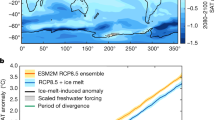Abstract
Climate change is expected over the next century as a result of anthropogenic emissions of greenhouse gases and aerosols into the atmosphere, and global average sea level will consequently rise. Estimates1 indicate that by 2100 sea level will be about 500 mm higher than today as a result of global warming, with thermal expansion of sea water accounting for over half of this rise. The melting of glaciers and ice sheets will contribute much of the remainder. We present an improved calculation of glacier melt, which uses the temperature patterns generated by a coupled atmosphere–ocean general circulation model2,3 as inputs to a seasonally and regionally differentiated glacier model4,5. Under specified greenhouse-gas and sulphate-aerosol forcings, our model predicts that glacier melt equivalent to 132 mm of sea-level rise will occur over the period 1990–2100, with a further 76 mm from melting of the Greenland ice sheet. These figures fall within the range of previous estimates made using simpler models1; the advantage of our approach is that we take into account the effects of regional and seasonal temperature variations. Our inclusion of these effects increases the calculated glacier melt by 20%.



Similar content being viewed by others
References
Warrick, R. A., Le Provost, C., Meier, M. F., Oerlemans, J. & Woodworth, P. L. in Climate Change 1995. The Science of Climate Change (eds Houghton, J. T. et al.) 359–406 (Cambridge Univ. Press, 1996).
Johns, T. C.et al. The second Hadley Centre coupled ocean–atmosphere GCM: Model description, spinup and validation. Clim. Dyn. 13, 103–134 (1997).
Mitchell, J. F. B., Johns, T. C., Gregory, J. M. & Tett, S. F. B. Climate response to increasing levels of greenhouse gases and sulphate aerosols. Nature 376, 501–504 (1995).
Oerlemans, J. in Ice in the Climate System (ed. Peltier, W. R.) (Springer, Berlin, 1993).
Zuo, Z. & Oerlemans, J. Contribution of glacier melt to sea level rise since AD 1865: a regionally differentiated calculation. Clim. Dyn. 13, 835–845 (1997).
Kattenberg, A.et al. in Climate Change 1995. The Science of Climate Change (eds Houghton, J. T. et al.) 285–358 (Cambridge Univ. Press, 1996).
Oerlemans, J. & Fortuin, J. P. F. Sensitivity of glaciers and small ice caps to greenhouse warming. Science 258, 115–117 (1992).
Oerlemans, J. Amodel for the surface balance of ice masses: Part I: Alpine glaciers. Z. Gletscherkunde Glazialgeol. 27/28, 63–83 (1991).
Oerlemans, J.et al. Modelling the response of glaciers to climate warming. Clim. Dyn. (in the press).
Meier, M. F. Contribution of small glaciers to global sea level. Science 226, 1418–1421 (1984).
Ingram, W. J., Wilson, C. A. & Mitchell, J. F. B. Modeling climate change: an assessment of sea ice and surface albedo feedbacks. J. Geophys. Res. 94, 8609–8622 (1989).
Mitchell, J. F. B., Manabe, S., Meleshko, V. & Tokioka, T. in Climate Change: The IPCC Scientific Assessment (eds Houghton, J. T., Jenkins, G. J. & Ephraums, J. J.) 131–172 (Cambridge Univ. Press, 1990).
Oerlemans, J. The mass balance of the Greenland ice sheet: sensitivity to climate change as revealed by energy-balance modelling. The Holocene 1, 40–49 (1991).
Thompson, S. L. & Pollard, D. Greenland and Antarctic mass balances for present and doubled atmospheric CO2from the GENESIS version-2 global climate model. J. Clim. 10, 871–899 (1997).
Leggett, J., Pepper, W. J. & Swart, R. J. in Climate Change 1992: The Supplementary Report ot the IPCC Scientific Assessment (eds Houghton, J. T., Callander, B. A. & Varney, S. K.) 69–96 (Cambridge Univ. Press, 1992).
Acknowledgements
R. L. H. Essery, W. J. Ingram and J. F. B. Mitchell made useful comments on the manuscript. J.A. Lowe helped with the calculation of thermal expansion. This work was partly supported by the UK Department of the Environment.
Author information
Authors and Affiliations
Corresponding author
Rights and permissions
About this article
Cite this article
Gregory, J., Oerlemans, J. Simulated future sea-level rise due to glacier melt based on regionally and seasonally resolved temperature changes. Nature 391, 474–476 (1998). https://doi.org/10.1038/35119
Received:
Accepted:
Issue Date:
DOI: https://doi.org/10.1038/35119
- Springer Nature Limited
This article is cited by
-
Surface mass balance analysis at Naradu Glacier, Western Himalaya, India
Scientific Reports (2021)
-
Modeling the impact of population density on carbon dioxide emission and its control: effects of greenbelt plantation and seaweed cultivation
Modeling Earth Systems and Environment (2019)
-
Assessing impact of climate change on Mundra mangrove forest ecosystem, Gulf of Kutch, western coast of India: a synergistic evaluation using remote sensing
Theoretical and Applied Climatology (2015)
-
Glaciers in the Earth’s Hydrological Cycle: Assessments of Glacier Mass and Runoff Changes on Global and Regional Scales
Surveys in Geophysics (2014)
-
Estimating the Glacier Contribution to Sea-Level Rise for the Period 1800–2005
Surveys in Geophysics (2011)





